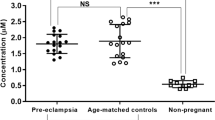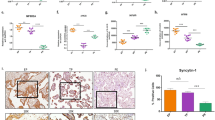Abstract
The systemic oxidative status in hypertensives disorders of pregnancy (HDP) and its association with endothelial dysfunction is controversial. In the present study, we evaluated systemic plasma levels of oxidative stress markers (TBARS (thiobarbituric acid-reactive substances) and carbonyl) and total antioxidant status (FRAP (ferric reducing ability of plasma (ferric reducing/antioxidant power) and reduction of MTT (3-(4,5-dimethylthiazol-2-yl)-2,5-diphenyltetrazolium bromide))), as well as assessed the impact these markers have on nitric oxide (NO) status in healthy pregnant (HP, n=38), gestational hypertensive (GH, n=33) and preeclamptic pregnant women (PE, n=28). We found similar values of TBARS among all groups, and reduced carbonyl levels in HDP between the PE and GH. Conversely, significant increases in plasma activity of antioxidant status were observed in the GH and PE groups compared to the HP group (using both MTT or FRAP method). Importantly, HDP present significantly lower nitrite levels compared to HP women. In Conclusion, our findings show a compensatory antioxidant mechanism against reactive oxygen species (ROS) generation in HDP, which is not associated with nitrite levels restoration.
This is a preview of subscription content, access via your institution
Access options
Subscribe to this journal
Receive 12 digital issues and online access to articles
$119.00 per year
only $9.92 per issue
Buy this article
- Purchase on Springer Link
- Instant access to full article PDF
Prices may be subject to local taxes which are calculated during checkout

Similar content being viewed by others

References
Walker JJ . Pre-eclampsia. Lancet 2000; 356 (9237): 1260–1265.
McCarthy AL, Woolfson RG, Raju SK, Poston L . Abnormal endothelial cell function of resistance arteries from women with preeclampsia. Am J Obstet Gynecol 1993; 168 (4): 1323–1330.
Roberts JM . Endothelial dysfunction in preeclampsia. Semin Reprod Endocrinol 1998; 16 (1): 5–15.
Gilbert JS, Ryan MJ, LaMarca BB, Sedeek M, Murphy SR, Granger JP . Pathophysiology of hypertension during preeclampsia: linking placental ischemia with endothelial dysfunction. Am J Physiol 2008; 294 (2): H541–H550.
Yoneyama Y, Suzuki S, Sawa R, Miura A, Doi D, Otsubo Y et al. Plasma nitric oxide levels and the expression of P-selectin on platelets in preeclampsia. Am J Obstet Gynecol 2002; 187 (3): 676–680.
Atamer Y, Kocyigit Y, Yokus B, Atamer A, Erden AC . Lipid peroxidation, antioxidant defense, status of trace metals and leptin levels in preeclampsia. Eur J Obstet Gynecol Reprod Biol 2005; 119 (1): 60–66.
Madazli R, Benian A, Aydin S, Uzun H, Tolun N . The plasma and placental levels of malondialdehyde, glutathione and superoxide dismutase in pre-eclampsia. J Obstet Gynaecol 2002; 22 (5): 477–480.
Panburana P, Phuapradit W, Puchaiwatananon O . Antioxidant nutrients and lipid peroxide levels in Thai preeclamptic pregnant women. J Obstet Gynaecol Res 2000; 26 (5): 377–381.
Diedrich F, Renner A, Rath W, Kuhn W, Wieland E . Lipid hydroperoxides and free radical scavenging enzyme activities in preeclampsia and HELLP (hemolysis, elevated liver enzymes, and low platelet count) syndrome: no evidence for circulating primary products of lipid peroxidation. Am J Obstet Gynecol 2001; 185 (1): 166–172.
Bowen RS, Moodley J, Dutton MF, Theron AJ . Oxidative stress in pre-eclampsia. Acta Obstet Gynecol Scand 2001; 80 (8): 719–725.
Sandrim VC, Palei AC, Metzger IF, Gomes VA, Cavalli RC, Tanus-Santos JE . Nitric oxide formation is inversely related to serum levels of antiangiogenic factors soluble fms-like tyrosine kinase-1 and soluble endogline in preeclampsia. Hypertension 2008; 52 (2): 402–407.
Williams DJ, Vallance PJ, Neild GH, Spencer JA, Imms FJ . Nitric oxide-mediated vasodilation in human pregnancy. Am J Physiol 1997; 272 (2 Pt 2): H748–H752.
Cockell AP, Poston L . Flow-mediated vasodilatation is enhanced in normal pregnancy but reduced in preeclampsia. Hypertension 1997; 30 (2 Pt 1): 247–251.
Buege JA, Aust SD . Microsomal lipid peroxidation. Methods Enzymol 1978; 52: 302–310.
Levine RL, Garland D, Oliver CN, Amici A, Climent I, Lenz AG et al. Determination of carbonyl content in oxidatively modified proteins. Methods Enzymol 1990; 186: 464–478.
Benzie IF, Strain JJ . The ferric reducing ability of plasma (FRAP) as a measure of ‘antioxidant power’: the FRAP assay. Anal Biochem 1996; 239 (1): 70–76.
Medina LO, Veloso CA, de Abreu Borges E, Isoni CA, Calsolari MR, Chaves MM et al. Determination of the antioxidant status of plasma from type 2 diabetic patients. Diabetes Res Clin Pract 2007; 77 (2): 193–197.
Dotan Y, Lichtenberg D, Pinchuk I . Lipid peroxidation cannot be used as a universal criterion of oxidative stress. Prog Lipid Res 2004; 43 (3): 200–227.
Gupta S, Agarwal A, Sharma RK . The role of placental oxidative stress and lipid peroxidation in preeclampsia. Obstet Gynecol Surv 2005; 60 (12): 807–816.
Montezano AC, Touyz RM . Molecular mechanisms of hypertension--reactive oxygen species and antioxidants: a basic science update for the clinician. Can J Cardiol 2012; 28 (3): 288–295.
Khan SR . Is oxidative stress, a link between nephrolithiasis and obesity, hypertension, diabetes, chronic kidney disease, metabolic syndrome? Urol Res 2012; 40 (2): 95–112.
Hill BG, Dranka BP, Bailey SM, Lancaster JR, Darley-Usmar VM . What part of NO don’t you understand? Some answers to the cardinal questions in nitric oxide biology. J Biol Chem 2010; 285 (26): 19699–19704.
Sandrim VC, Palei AC, Metzger IF, Cavalli RC, Duarte G, Tanus-Santos JE . Interethnic differences in ADMA concentrations and negative association with nitric oxide formation in preeclampsia. Clin Chim Acta 2010; 411 (19-20): 1457–1460.
Hamberg M, Svensson J, Samuelsson B . Thromboxanes: a new group of biologically active compounds derived from prostaglandin endoperoxides. Proc Nat Acad Sci USA 1975; 72 (8): 2994–3018.
Regan CL, Levine RJ, Baird DD, Ewell MG, Martz KL, Sibai BM et al. No evidence for lipid peroxidation in severe preeclampsia. Am J Obstet Gynecol 2001; 185 (3): 572–578.
Zusterzeel PL, Mulder TP, Peters WH, Wiseman SA, Steegers EA . Plasma protein carbonyls in nonpregnant, healthy pregnant and preeclamptic women. Free Radic Res 2000; 33 (5): 471–476.
Llurba E, Gratacos E, Martin-Gallan P, Cabero L, Dominguez C . A comprehensive study of oxidative stress and antioxidant status in preeclampsia and normal pregnancy. Free Radic Biol Med 2004; 37 (4): 557–570.
Harsem NK, Braekke K, Staff AC . Augmented oxidative stress as well as antioxidant capacity in maternal circulation in preeclampsia. Eur J Obstet Gynecol Reprod Biol 2006; 128 (1-2): 209–215.
Ellis G, Adatia I, Yazdanpanah M, Makela SK . Nitrite and nitrate analyses: a clinical biochemistry perspective. Clin Biochem 1998; 31 (4): 195–220.
Ranta V, Viinikka L, Halmesmaki E, Ylikorkala O . Nitric oxide production with preeclampsia. Obstet Gynecol 1999; 93 (3): 442–445.
Schiessl B, Strasburger C, Bidlingmaier M, Mylonas I, Jeschke U, Kainer F et al. Plasma- and urine concentrations of nitrite/nitrate and cyclic Guanosinemonophosphate in intrauterine growth restricted and preeclamptic pregnancies. Arch Gynecol Obstet 2006; 274 (3): 150–154.
Aydin S, Benian A, Madazli R, Uludag S, Uzun H, Kaya S . Plasma malondialdehyde, superoxide dismutase, sE-selectin, fibronectin, endothelin-1 and nitric oxide levels in women with preeclampsia. Eur J Obstet Gynecol Reprod Biol 2004; 113 (1): 21–25.
Kleinbongard P, Dejam A, Lauer T, Rassaf T, Schindler A, Picker O et al. Plasma nitrite reflects constitutive nitric oxide synthase activity in mammals. Free Radic Biol Med 2003; 35: 790–796.
Sandrim VC, Montenegro MF, Palei AC, Metzger IF, Sertorio JT, Cavalli RC et al. Increased circulating cell-free hemoglobin levels reduce nitric oxide bioavailability in preeclampsia. Free Radic Biol Med 2010; 49 (3): 493–500.
Savvidou MD, Hingorani AD, Tsikas D, Frolich JC, Vallance P, Nicolaides KH . Endothelial dysfunction and raised plasma concentrations of asymmetric dimethylarginine in pregnant women who subsequently develop pre-eclampsia. Lancet 2003; 361 (9368): 1511–1517.
Acknowledgements
This study was funded by the Fundação de Amparo, a Pesquisa do Estado de Minas Gerais (FAPEMIG-Brazil), the Conselho Nacional de Desenvolvimento Científico e Tecnológico (CNPq), Fundação de Amparo a Pesquisa do Estado de São Paulo (FAPESP-Brazil) and IEP–SCBH–Instituto de Ensino e Pesquisa da Santa Casa de Belo Horizonte. We also thank Dr JP Granger, full professor in the Department of Physiology and Biophysics of the University of Mississippi Medical Center (Jackson/MS, USA), for his assistance in the language editing of this manuscript.
Author information
Authors and Affiliations
Corresponding author
Ethics declarations
Competing interests
The authors declare no conflict of interest.
Rights and permissions
About this article
Cite this article
Gomes, H., Palei, A., Machado, J. et al. Assessment of oxidative status markers and NO bioavailability in hypertensive disorders of pregnancy. J Hum Hypertens 27, 345–348 (2013). https://doi.org/10.1038/jhh.2012.58
Received:
Revised:
Accepted:
Published:
Issue Date:
DOI: https://doi.org/10.1038/jhh.2012.58
Keywords
This article is cited by
-
The Change of Oxidative Stress in Maternal Blood During Pregnancy
Reproductive Sciences (2022)
-
Evaluation of genetic instability, oxidative stress, and metabolism-related gene polymorphisms in workers exposed to waste anesthetic gases
Environmental Science and Pollution Research (2022)
-
Vascular xanthine oxidoreductase contributes to the antihypertensive effects of sodium nitrite in l-NAME hypertension
Naunyn-Schmiedeberg's Archives of Pharmacology (2014)


